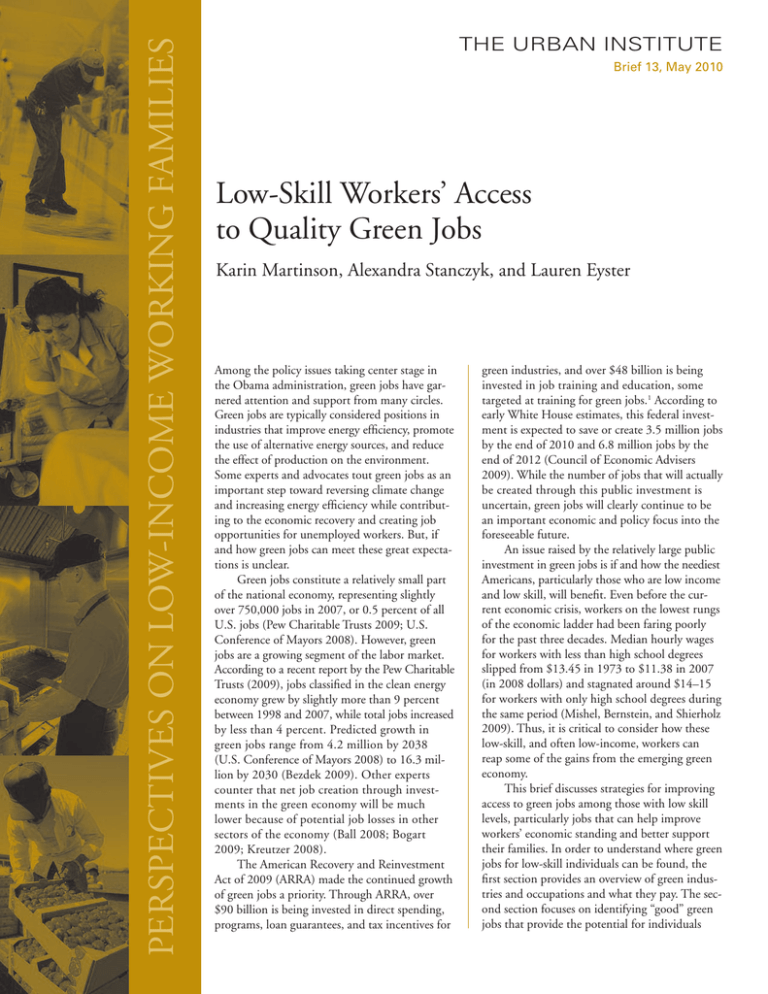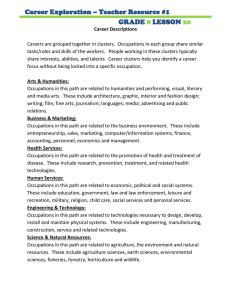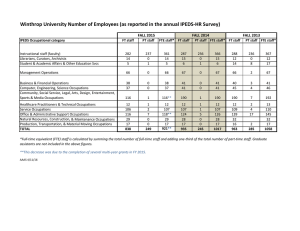Low-Skill Workers’ Access to Quality Green Jobs THE URBAN INSTITUTE
advertisement

PERSPECTIVES ON LOW-INCOME WORKING FAMILIES THE URBAN INSTITUTE Brief 13, May 2010 Low-Skill Workers’ Access to Quality Green Jobs Karin Martinson, Alexandra Stanczyk, and Lauren Eyster Among the policy issues taking center stage in the Obama administration, green jobs have garnered attention and support from many circles. Green jobs are typically considered positions in industries that improve energy efficiency, promote the use of alternative energy sources, and reduce the effect of production on the environment. Some experts and advocates tout green jobs as an important step toward reversing climate change and increasing energy efficiency while contributing to the economic recovery and creating job opportunities for unemployed workers. But, if and how green jobs can meet these great expectations is unclear. Green jobs constitute a relatively small part of the national economy, representing slightly over 750,000 jobs in 2007, or 0.5 percent of all U.S. jobs (Pew Charitable Trusts 2009; U.S. Conference of Mayors 2008). However, green jobs are a growing segment of the labor market. According to a recent report by the Pew Charitable Trusts (2009), jobs classified in the clean energy economy grew by slightly more than 9 percent between 1998 and 2007, while total jobs increased by less than 4 percent. Predicted growth in green jobs range from 4.2 million by 2038 (U.S. Conference of Mayors 2008) to 16.3 million by 2030 (Bezdek 2009). Other experts counter that net job creation through investments in the green economy will be much lower because of potential job losses in other sectors of the economy (Ball 2008; Bogart 2009; Kreutzer 2008). The American Recovery and Reinvestment Act of 2009 (ARRA) made the continued growth of green jobs a priority. Through ARRA, over $90 billion is being invested in direct spending, programs, loan guarantees, and tax incentives for green industries, and over $48 billion is being invested in job training and education, some targeted at training for green jobs.1 According to early White House estimates, this federal investment is expected to save or create 3.5 million jobs by the end of 2010 and 6.8 million jobs by the end of 2012 (Council of Economic Advisers 2009). While the number of jobs that will actually be created through this public investment is uncertain, green jobs will clearly continue to be an important economic and policy focus into the foreseeable future. An issue raised by the relatively large public investment in green jobs is if and how the neediest Americans, particularly those who are low income and low skill, will benefit. Even before the current economic crisis, workers on the lowest rungs of the economic ladder had been faring poorly for the past three decades. Median hourly wages for workers with less than high school degrees slipped from $13.45 in 1973 to $11.38 in 2007 (in 2008 dollars) and stagnated around $14–15 for workers with only high school degrees during the same period (Mishel, Bernstein, and Shierholz 2009). Thus, it is critical to consider how these low-skill, and often low-income, workers can reap some of the gains from the emerging green economy. This brief discusses strategies for improving access to green jobs among those with low skill levels, particularly jobs that can help improve workers’ economic standing and better support their families. In order to understand where green jobs for low-skill individuals can be found, the first section provides an overview of green industries and occupations and what they pay. The second section focuses on identifying “good” green jobs that provide the potential for individuals An Urban Institute Program to Assess Changing Social Policies to support themselves and their families. Other sections discuss how training for green jobs can equip low-skill workers with needed skills, provide recommendations for improving these training efforts, and detail examples of innovative programs. What Are Green Jobs? Key Industries and Occupations Despite all the attention given to the green economy, no consistent definition or classification of green industries and occupations exists. In various efforts to define, count, and predict growth in green jobs, experts and advocates use different terminologies or groupings of green industries. For example, differences occur over whether an industry should be considered green only if the good or service it produces is green (such as wind energy generation or solar panel installation) or also if the good or service is not considered green but the industry has instituted green practices (such as recycling or energy conservation measures). In broad terms, green industries typically fall under the traditional sectors of energy, construction, manufacturing, and transportation. Specific industries within these sectors that have received the most focus in domestic conversations about the green economy involve renewable energy, energy-efficiency products, building retrofitting, biofuel development, public transportation, and environmental cleanup (Environmental Defense Fund 2008; Matera 2009; U.S. Conference of Mayors 2008; Vice President’s Middle Class Task Force 2009). For example, ARRA draws on language in the Green Jobs Act of 2007 to define target industries for green jobs as those in “energy efficiency and renewable energy industries.” In the international arena, a much-cited definition developed by the United Nations offers a broader definition encompassing additional industries that involve materials and water conservation, environmental quality, biodiversity, and ecosystems maintenance (United Nations Environment Programme 2008).2 Box 1 shows the industries commonly cited as green or “greening” industries. The distinction between green and greening industries reflects the fact that some industries, such as wind and solar energy, are relative new and unambiguously green, while other more traditional industries, such as construction and manufacturing, are incorporating new green practices, inputs, or products. The Bureau of Labor Statistics (BLS) has begun to standardize occupational and industry definitions within the green economy in order to measure the number of green jobs by industry and geography, changes over time, pay, and the skills and training needed. Longitudinal survey data will be collected from this effort so employment rates and growth projections for these occupations can be provided systematically (Woods 2009). A recent report by the U.S. Department of Labor (DOL)–funded Occupational Information Network provides one of the most comprehensive occupational-level looks at the green economy available. Examining and reporting what effect the green economy is having on occupations, the report identifies three general categories of greening occupations, including occupations in increasing demand due to the green economy, occupations that demand slightly different or BOX 1. Green and “Greening” Industries Solar power Rail transportation Hydroelectric power generation Electric power generation, transmission, and distribution m Motor vehicle electric equipment manufacturing m Engineering, legal, research, and consultation m m m m Crop production Utilities Basic chemical manufacturing Engine, turbine, and power transmission equipment manufacturing m Power and communication line construction m Wind power m Construction m m m m Sources: Bivens, Irons, and Pollack (2009); Bragin et al. (2009); Pollin and Wicks (2008); U.S. Conference of Mayors (2008); Vice President’s Middle Class Task Force (2009); White and Walsh (2008); Wider Opportunities for Women (2009b). Note: The authors generated this list through a review of the major reports on green jobs. This list is meant to represent commonly cited green and greening industries in the green jobs literature and is not exhaustive. 2 An Urban Institute Program to Assess Changing Social Policies increased skill levels than similar occupations in traditional industries, and unique occupations developed in the green industries that demand unique work and worker requirements (Dierdoff et al. 2009). A major conclusion in the green jobs literature, including the DOL work described above, is that, while the green economy involves some relatively new industries and occupations, many occupations are similar to those in traditional industries. For example, manufacturing greenrelated products demands the standard skills provided by machinists, technicians, and metal workers. Green construction and retrofitting also requires relatively standard job skills provided by electricians, equipment installers, carpenters, equipment operators, building inspectors, truck drivers, and welders. Thus, while some specialized training in new skills and practices may be needed, there are relatively few entirely new occupations in green industries, especially in the low- and middle-skill arena (White and Walsh 2008). Given where green jobs are found, women may be less likely than men to benefit from investments in the green economy. The projected growth of green jobs is concentrated in overwhelmingly male-dominated industries and occupations. In 2007, women represented only 4 percent of all employees in natural resources, construction, and maintenance and only 23 percent in production, transportation, and material moving (BLS 2007). Are Green Jobs Good Jobs? If the goal is to help low-skill workers improve their economic success, another critical issue is whether green jobs are actually worth pursuing. That is, are there “good” green jobs that would allow low-skill individuals to support their families and move up the economic ladder? Some studies suggest that green jobs are generally higher quality than the average American job. A report from the Council of Economic Advisers for the Vice President’s Middle Class Task Force indicates that some occupations in green industries pay above-average wages (Vice President’s Middle Class Task Force 2009). Because of the improved job quality in the green economy, other studies estimate that increased investments in the green economy will increase the relative wages of U.S. workers without college degrees (Bivens et al. 2009). Researchers also highlight the unionization of green jobs as a pathway to higher wages for lower-skill workers.3 Despite these projections, green industries clearly consist of a range of high-, middle-, and low-skill jobs at varying levels of pay (figure 1). Highly skilled green jobs, including engineers and scientists as well as white-collar jobs in management, pay more than $30 an hour. At the same time, some green-related jobs are, and will continue to be, low paying, with little opportunity for advancement. These low-skill, low-paying jobs that workers with high school degrees can obtain without additional training typically pay FIGURE 1. Number of Green Occupations, by Green Sector and Skill Level 80 High-skill Middle-skill Low-skill Number of green occupations 70 60 50 40 30 20 10 0 Renewable energy generation Energy efficiency Green construction Manufacturing Source: Authors’ compilation of green occupations by sectors in Dierdoff et al. (2009). 3 An Urban Institute Program to Assess Changing Social Policies less than $15 an hour. Examples of low-skill jobs in the green sectors include drivers, some assembly-line workers, insulation workers, boilermakers, and some construction laborers. One strategy to improve the quality of jobs in lower-skill occupations may make them good jobs. These efforts, which typically focus on labor agreements and increases in wage standards, include attaching wage requirements to companies in green industries that take state and federal subsidies, applying wage standards to government contractors, and adding labor criteria to Leadership in Energy and Environmental Design standards (Good Jobs First 2009; Weber 2009). Taking a step in this direction, the Obama administration recently issued guidance requiring all contractors receiving ARRA funds to pay laborers and mechanics the prevailing wage or as least as much as workers on similar projects in the same region.4 With $49.3 billion for transportation construction and $5 billion for home weatherization projects for low-income families, this ruling will affect a significant number of jobs. But labor agreements and wage standards may not be enough to help low-skill individuals move toward greater economic security. The best opportunities to help these workers achieve this goal are likely to come from middle-skill jobs. These are jobs in occupations that require some postsecondary education (but not a four-year college degree) and pay above $15 an hour, with many also providing benefits. Middle-skill jobs typically require specialized skill training but can offer advancement to supervisory or managerial positions. Green occupations in this category include mechanics, technicians, and electricians. Several studies indicate that green jobs do and will continue to be concentrated in this middle-skill sector (Bivens et al. 2009; Oregon Employment Department 2009). As shown in figure 1, over half the occupations in renewable energy are middle-skill jobs such as geothermal heat pump machinists and biofuel processing technicians; less than a tenth are low-skill jobs. Similarly, almost half the occupations in the energy efficiency industry, which include energy auditors and installers, are considered middle skill. Employees in these middle-skill occupations generally need one or two years of training including both on-the-job experience and formalized classroom training. Often, completion of an apprenticeship program, vocational training program, or certificate or licensure is required. Overall, there are green jobs that would help low-skill workers support themselves and their families. But action must be taken to ensure these 4 individuals gain access to these jobs, particularly through training that provides them with the necessary skills to succeed. Training Low-Skill Individuals for Green Jobs For workers already trained for occupations in traditional industries, many middle-skill green jobs will require little additional training. Core skills are typically most important, and green competencies can usually be learned either in tandem with or after learning the core skills associated with a given occupation (Krepcio 2009). Many low-skill individuals are likely to need additional training to acquire needed job skills. Recessionary periods, when competition for jobs is tight, can be an important time for low-skill individuals who are unemployed or underemployed to invest in the training they need to move ahead in the future. However, if low-income individuals are to gain the skills necessary to access higherquality green jobs, training programs should be well designed to meet the needs of this population. Too often training programs have not worked well for those at lower income levels because the combination of high education costs, family obligations, work schedules, and a lack of access to support services make it difficult to work, go to school, and care for a family. Fortunately, several strategies show promise in making training possible for low-skill individuals, whether in green jobs or not. These strategies include the following five: m m m Curricular reforms at community colleges and other training providers, such as bridge programs that increase low-skill individuals’ access to higher levels of training and modularized curricula that low-income students can use to combine work and education or cycle in and out of programs. Strong partnerships between employers and training providers to ensure that training is strongly linked to employer needs. All green-related jobs won’t suddenly be in high demand everywhere, and states and localities need to work closely with the business community to ensure jobs are available for those who receive training. Career paths that create opportunities for low-skill workers to advance.5 This strategy, which also relies on strong partnerships with business, uses on-the-job experience of entrylevel workers combined with training to ensure career and wage progression within a company or an industry. An Urban Institute Program to Assess Changing Social Policies m m Financial assistance to help low-wage workers afford school and meet their expenses. This would mean expanding educational assistance programs to include those who are typically not eligible, particularly part-time students or those without high school diplomas. Stipends for meeting program benchmarks and for course completion have also been shown to increase persistence in training programs. Recruitment efforts and support services for nontraditional workers. To connect lowincome women and minorities with middleskill green jobs, training providers need to increase awareness of green jobs and training opportunities among these subpopulations through outreach, education, and recruitment. Training curricula should be tailored to address issues that may be particularly relevant to women and minorities in these occupations, such as job readiness, life skills, sexual harassment awareness, and applied basic skills. Additionally, because these individuals may face particular barriers to participating in and completing training, providers should offer support services such as child care, flexible schedules, and transportation assistance (Liu and Keleher 2009; Wider Opportunities for Women 2009a, 2009b). Some community organizations, unions, and community colleges have started developing training for green jobs geared toward low-skill workers. For example, the Garden State Alliance for a New Economy, a partnership of union and communitybased organizations, developed and operates a six-week training program in weatherization and green construction targeted to low-income workers in Newark, New Jersey. The program also targets a diverse group of low-income individuals to participate as the construction industry is disproportionately male and white (Atkins 2009).6 Another training program at the Columbia Gorge Community College on the northwest Oregon–Washington border offers opportunities for low-skill workers to enter the renewable energy industry as a wind energy technician or supervisor—a middle-skill occupation with a starting hourly wage of $18–30. While the program takes students of all income levels, it works with local one-stop career centers to recruit Oregon- and Washington-area residents with low skill levels and provide them with tuition assistance. For some applicants, the program’s math requirements can be challenging, so the college has increased the number of basic math courses (that may be paid for by the one-stop) to increase applicants’ chances of qualifying for the program.7 Finally, Sustainable South Bronx, an environmental advocacy organization in operation since 2001, offers the Bronx Environmental Stewardship Training program. This 14–16-week green jobs training program is targeted at lowincome residents and those with serious barriers to employment; most students are on public assistance, and around half have prison records. The training curriculum, developed with local employers, covers green building, environmental cleanup, and green landscaping; trainees gain professional certificates like the NYC Tree Pruner Certification and the 10-Hour OSHA Certification and Herbicide/Pesticide Applicator Certification, among others. The program is notable for its focus on job placement, connections to employers, and industry-recognized certificates (Cha 2009; Dafoe 2007).8 Opportunities for Moving Forward Recently, even before the emphasis on green job development, the nation’s workforce system has been financially strained, with dwindling public funds to successfully provide access to the jobs, training, and supports that low-skill workers need. However, even in these difficult economic times, important efforts can help states and localities move forward in developing training options to help low-skill workers benefit from the investment in green jobs. For example, additional resources and direction provided by ARRA offer a unique opportunity to rebuild and improve the public workforce system. Although these funds are time limited, the considerable ARRA funding provided through the Workforce Investment Act (WIA) for unemployed workers and those displaced from their previous jobs can be used to retrain for green and other high-growth jobs. Importantly, the departments of Labor and Energy are implementing several new programs funded by ARRA that provide resources to state and local governments and national and community-based nonprofit organizations to green jobs initiatives. One DOL grant program, called Pathways Out of Poverty, targets green job training for low-income individuals. Thirty-eight grants to national and community-based organizations ranging from $2 to $8 million each, and totaling $150 million, were awarded in January 2010. Based on a review of the grant descriptions, the activities planned by recipients include several strategies discussed in this brief such as curricular reforms, partnerships, and career pathways. The grant descriptions also emphasize supportive 5 An Urban Institute Program to Assess Changing Social Policies services for low-income training participants to help them complete training and succeed in the workforce. However, little attention is paid to specific recruitment efforts of nontraditional workers such as women and minorities in construction and advanced manufacturing. Several federal legislative opportunities could also bring more resources to training low-skill workers in the green economy as well as other sectors. The Obama administration’s proposed American Graduation Initiative (AGI) would provide $12 billion to build the capacity of the country’s community college system, increase financial aid for low-income students through Pell grants, and develop strategies to encourage college completion to make the innovations in job training, including training in green occupations. The final postsecondary education provisions passed through the Health Care and Education Reconciliation Act of 2010 included the Pell grant reforms but left out most of the AGI provisions (Hilliard and Duke-Benfield 2010). While the AGI provisions may be pursued in the future, some community colleges like Columbia Gorge Community College are moving ahead of these national proposals to build training capacity for green jobs. In addition, some are advocating for reforms to the public workforce system to improve job training for low-skill workers through WIA reauthorization, which is scheduled to occur in 2010 (Center for Law and Social Policy 2009). While federal action and resources are critical, the real action of green job development and training will occur regionally and locally. To achieve success, it is important for state and local workforce development agencies to reposition their services to address the new focus on green jobs. Local green jobs initiatives should involve regional planning efforts with economic, community, and workforce development agencies at the table, and focus on serving low-wage and low-skill adults and youth through incorporating curricular reforms and supportive services in green jobs training programs. Several local green jobs efforts that are already under way bring together key stakeholders to develop or refocus training programs on the green economy. For example, in New York City, Urban Agenda’s Apollo Alliance partners with business, labor unions, workforce development organizations, environmental organizations, and community organizations to develop jobs in green sectors and connects them to low-income residents.9 Efforts must be made to ensure that partnerships among key players last past initial funding stages to promote the sustainability of green jobs initiatives. 6 Without clear leadership and direction from state and local policymakers and officials, along with a willingness to take advantage of the current opportunities for improving green job training for low-skill workers, these workers may find themselves at the end of a very long queue of more experienced individuals and will be unable to move ahead even when economic recovery does occur. Notes 1. This estimate includes a more expansive list of education and training investments, and is therefore higher than some estimates (Fox, Walsh, and Fremstad 2009). 2. Green jobs advocacy groups and the Vice President’s Middle Class Task Force introduce quality into their definitions of green jobs, contending that, by definition, green jobs are well paid, career-track jobs (Apollo Alliance and Green For All 2008; Vice President’s Middle Class Task Force 2009). 3. For example, one study estimates that 16 percent of newly created green jobs will be unionized, compared with 12 percent in the overall economy (Bivens et al. 2009). 4. See U.S. Department of Labor, “Applicability of DavisBacon Labor Standards to Federal and Federally Assisted Construction Work Funded in Whole or in Part under Provisions of the American Recovery and Reinvestment Act of 2009,” Memorandum No. 207, May 29, 2009. 5. This strategy has had some success in apprenticeship programs and in the health and hospitality sectors, among others. 6. Information also came from Kate Atkins, interview with the authors, September 10, 2009. 7. Susan Wolff, interview with the authors, September 17, 2009. 8. See also Sustainable South Bronx, “Best Academy: Bronx Environmental Stewardship Training Academy,” http://www.ssbx.org/index.php (accessed April 16, 2010). 9. Urban Agenda’s Apollo Alliance projects include convening a “green jobs roundtable” that brings together stakeholders to create recommendations for the city leadership, identify green training opportunities across the city (particularly those geared toward low-skill individuals), and examine the use of ARRA funds. References Apollo Alliance and Green For All. 2008. Green-Collar Jobs in America’s Cities: Building Pathways out of Poverty and Careers in the Clean Energy Economy. San Francisco: Apollo Alliance and Green For All. An Urban Institute Program to Assess Changing Social Policies Atkins, Kate. 2009. “Garden State Alliance for a New Economy (GANE) and Laborers Local 55 Weatherization Initiative.” Presentation at “A New Safety Net for Working Families: Green Jobs and Low-Wage Workers,” the Urban Institute, Washington, D.C., April 21. Ball, Jeffery. 2008. “Does Green Energy Add 5 Million Jobs? Potent Pitch, but Numbers Are Squishy.” Washington, DC: American Enterprise Institute. Bezdek, Roger H. 2009. Green-Collar Jobs in the U.S. and Colorado: Economic Drivers for the 21st Century. Boulder, CO: American Solar Energy Society. Bivens, Josh, John Irons, and Ethan Pollack. 2009. “Green Investments and the Labor Market: How Many Jobs Could be Generated and What Type?” Washington, DC: Economic Policy Institute. Bogart, William T. 2009. “Green Jobs and Their Role in Our Economic Recovery.” Testimony before the House Committee on Energy and Labor, Subcommittee on Workforce Protections, March 31. Bragin, Gideon, Katherine Klosek, Tyler Moazed, and Jamie Statter. 2009. An Analysis of Green Jobs in Baltimore: Growing Local Employment as America’s Economy Recovers. Baltimore, MD: Mayor’s Office of Employment Development. Bureau of Labor Statistics. 2007. Employed Persons by Detailed Occupation and Sex, 2007 Annual Averages. Washington, DC: U.S. Department of Labor, Bureau of Labor Statistics. Center for Law and Social Policy (CLASP). 2009. “Recommendations to Refocus WIA Title II on Career and Postsecondary Success.” Washington, DC: CLASP. Cha, Mijin J. 2009. “The New York City Apollo Alliance.” Presentation at “A New Safety Net for Working Families: Green Jobs and Low-Wage Workers,” the Urban Institute, Washington, D.C., April 21. Council of Economic Advisers. 2009. Estimates of Job Creation from the American Recovery and Reinvestment Act of 2009. Washington, DC: Executive Office of the President. Dafoe, Jack. 2007. “Growing Green-Collar Jobs: Energy Efficiency.” New York: Urban Agenda. Dierdoff, Erich C., Jennifer J. Norton, Donald W. Drews, Christina M. Kroustalis, David Rivkin, and Phil Lewis. 2009. “Greening of the World of Work: Implications for O*NET SOC and New and Emerging Occupations.” Raleigh, NC: National Center for O*NET Development. Environmental Defense Fund. 2008. “Green Jobs Guidebook: Employment Opportunities in the New Clean Economy.” Washington, DC: Environmental Defense Fund. Fox, Radhika, Jason Walsh, and Shawn Fremstad. 2009. “Bringing Home the Green Recovery: A User’s Guide to the 2009 American Recovery and Reinvestment Act.” Oakland, CA: Green For All. Good Jobs First. 2009. “High Road or Low Road? Job Quality in the New Green Economy.” Washington, DC: Good Jobs First. Hilliard, Thomas, and Amy Ellen Duke-Benfield. 2010. “Reconciliation: Important Gains in Post-Secondary Education, but Also Missed Opportunities.” Washington, DC: Center for Law and Social Policy. Krepcio, Kathy. 2009. “Preparing the American Workforce for a Green Jobs Economy.” Testimony before the House Committee on Education and Labor, Subcommittee on Workforce Protections, March 31. Kreutzer, David W. 2008. “Impact of CO2 Restrictions of Employment and Income: Green Jobs or Gone Jobs?” Web memo. Washington, DC: The Heritage Foundation. Liu, Yvonne Yen, and Terry Keleher. 2009. Green Equity Toolkit: Standards and Strategies for Advancing Race, Gender, and Economic Equity in the Green Economy. Oakland, CA: Applied Research Center. Matera, Philip. 2009. “High Road or Low Road: Job Quality in the New Green Economy.” Washington, DC: Good Jobs First. Mishel, Lawrence, Jared Bernstein, and Heidi Shierholz. 2009. The State of Working America 2008/2009. Ithaca, NY: ILR Press. Oregon Employment Department. 2009. The Greening of Oregon’s Workforce: Jobs, Wages, and Training. Salem: Oregon Employment Department, Workforce and Economic Development Research Division. Pew Charitable Trusts, The. 2009. “The Clean Energy Economy: Repowering Jobs, Businesses, and Investments across America.” Washington, DC: The Pew Charitable Trusts. Pollin, Robert, and Jeannette Wicks. 2008. “Job Opportunities for the Green Economy: A State-by-State Picture of Occupations That Gain from Green Investments.” Amherst: Political Economy Research Institute, University of Massachusetts, Amherst. U.S. Conference of Mayors. 2008. U.S. Metro Economies: Current and Potential Green Jobs in the U.S. Economy. Washington, DC: U.S. Conference of Mayors United Nations Environment Programme. 2008. “Green Jobs: Towards Decent Work in a Sustainable, Low-Carbon World.” Nairobi, Kenya: United Nations Environment Programme. Vice President’s Middle Class Task Force. 2009. Green Jobs: A Pathway to a Strong Middle Class. Staff report. Washington, DC: The White House. Weber, Christopher. 2009. “Green Jobs for Whom? Obama Must Ensure That the Green Economy Provides a Living Wage and Opportunity for All.” In These Times, February 9. http://www.inthesetimes.com/article/4194/green_jobs_ for_whom/. 7 An Urban Institute Program to Assess Changing Social Policies White, Sarah, and Jason Walsh. 2008. “Greener Pathways: Jobs and Workforce Development in the Clean Energy Economy.” Madison: Center on Wisconsin Strategy. Wider Opportunities for Women. 2009a. “Integrating Women into Nontraditional Occupations.” Washington, DC: Wider Opportunities for Women. ———. 2009b. “Women and the Green Economy: An Opportunity for Economic Security.” Washington, DC: Wider Opportunities for Women. Woods, Jim. 2009. Measurement and Analysis of Employment in the Green Economy: Workforce Information Council Green Jobs Study Group Final Report. Washington, DC: U.S. Department of Labor, Bureau of Labor Statistics. About the Authors Karin Martinson is a senior research associate in the Urban Institute’s Center on Labor, Human Services, and Population. Her research interests 8 include welfare reform, employment and training programs, service delivery systems, and work supports. She has worked on numerous program evaluations in these areas, with a focus on implementation studies of programs and services for low-income families. Alexandra Stanczyk is a research assistant in the Urban Institute’s Center on Labor, Human Services and Population. She works on projects investigating workforce development, work support, child care, and housing policies. Lauren Eyster is a research associate in the Urban Institute’s Center on Labor, Human Services, and Population. She studies the implementation and impacts of policies and programs affecting American workers and their families, namely workforce development, welfare, child welfare, and child care issues. THE URBAN INSTITUTE Nonprofit Org. US Postage PAID Easton, MD Permit No. 8098 2100 M Street, NW Washington, DC 20037 Return Service Requested To download this document, visit our web site, http://www.urban.org. For media inquiries, please contact paffairs@urban.org. This brief is part of the Urban Institute’s Low-Income Working Families project, a multiyear effort that focuses on the private- and public-sector contexts for families’ success or failure. Both contexts offer opportunities for better helping families meet their needs. The Low-Income Working Families project is currently supported by The Annie E. Casey Foundation and The John D. and Catherine T. MacArthur Foundation. THE URBAN INSTITUTE 2100 M Street, NW Washington, DC 20037 Copyright © 2010 Phone: 202-833-7200 Fax: 202-467-5775 E-mail: pubs@urban.org The views expressed are those of authors and do not necessarily reflect those of the Urban Institute, its boards, its sponsors, or other authors in the series. Permission is granted for reproduction of this document with attribution to the Urban Institute.





